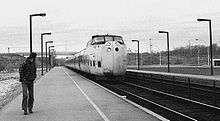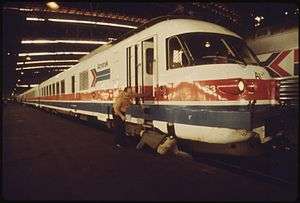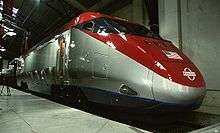Gas turbine train

A gas turbine train is a passenger train that uses one or more gas turbines as its main source of power. Few passenger trains use this system today, although there has been one recent prototype built by Bombardier Transportation.
Description
A gas turbine train typically consists of two power cars (one at each end of the train), and one or more intermediate passenger cars.
In a gas turbine power car a turbine engine, similar to a turboshaft engine, drives an output shaft that is in turn attached to a hydraulic or electric transmission, or (in the case of the UAC TurboTrain) a mechanical gearbox,[1] which supplies power to drive the wheels.
A gas turbine offers some advantages over a piston engine. There are few moving parts, decreasing the need for lubrication and potentially reducing maintenance costs, and the power-to-weight ratio is much higher. A turbine of a given power output is also physically smaller than an equally powerful piston engine, often allowing the power car to accommodate passengers or cargo as well. However, a turbine's power output and efficiency both drop dramatically with rotational speed, unlike a piston engine, which has a comparatively flat power curve.
Examples
United Kingdom
British Rail invested in experimentation with the new jet turbines in the early to mid 1950s. Most examples were built for the Western region (because of the oversized loading gauge compared with the rest of the network). The last attempt before APT-E was GT3 in 1962, but by then British Rail had favoured diesel and electric locomotives, and the project was scrapped.
The gas turbine investigations were rekindled with the construction of British Rail APT-E, prototype of the Advanced Passenger Train. Like the French TGV, later models were electric instead.
France
SNCF (French National Railways) used a number of gas-turbine trainsets, called the Turbotrain, in non-electrified territory. These typically consisted of a power car at each end with three cars between them. Turbotrain was in use up until 2005. After retirement, 4 sets were sold for further use in Iran.
The first TGV prototype, TGV 001, was also powered by a gas turbine, but steep oil prices prompted the change to overhead electric lines for power delivery.
United States

In the 1960s United Aircraft built the Turbo passenger train, which was tested by the Pennsylvania Railroad and later used by Amtrak and Via Rail. Via's remained in service into the 1980s and had an excellent maintenance record during this period, but were eventually replaced by the LRC in 1982.
In 1966, the Long Island Rail Road tested an experimental gas turbine railcar (numbered GT-1), powered by two Garrett turbine engines. This car was based on a Budd Pioneer III design, with transmissions similar to Budd's 1950s era RDCs. The car was later modified (as GT-2) to add the ability to run on electric third rail as well.[2][3]
In 1977, the LIRR tested eight more gas turbine-electric/electric dual mode railcars, in an experiment sponsored by the USDOT. Four of these cars had GE-designed powertrains, while the other four had powertrains designed by Garrett (four more cars had been ordered with GM/Allison powertrains, but were canceled). These cars were similar to LIRR's M1 EMU cars in appearance, with the addition of step wells for loading from low level platforms. The cars suffered from poor fuel economy and mechanical problems, and were withdrawn from service after a short period of time. The four GE-powered cars were converted to M1 EMUs and the Garrett cars were scrapped.[4]
Amtrak purchased two different types of turbine-powered trainsets, which were both called Turboliners. The sets of the first type were similar in appearance to SNCF's T 2000 Turbotrain, though compliance with FRA safety regulations made them heavier and slower than the French trains. None of the first-type Turboliners remain in service. Amtrak also added a number of similarly named Rohr Turboliners (or RTL) to its roster. There were plans to rebuild these as RTL IIIs, but the program has been cancelled and the units are being sold or scrapped.
Canada

Canadian National Railways (CN) was one of the operators of the Turbo, which were passed on to Via Rail. They operated on the major Toronto-Montreal route between 1968 and 1982, when they were replaced by the LRC.
In 2002 Bombardier Transportation announced the launch of the JetTrain, a high-speed trainset consisting of tilting carriages and a locomotive powered by a Pratt & Whitney turboshaft engine. One prototype was built and tested, but no JetTrains have yet been sold for service.
See also
References
- ↑ Shron, Jason (2008). TurboTrain: A Journey. Rapido Trains Inc.. ISBN 978-0-9783611-0-5.
- ↑ http://world.nycsubway.org/perl/show?42662
- ↑ http://world.nycsubway.org/perl/show?10670
- ↑ http://www.trainsarefun.com/lirr/lirrextralist/lirrextralist.htm
